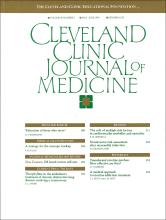Table of Contents
From the Editor
Highlights from Medical Grand Rounds
- Surgeon’s Skill Key to Ovarian Cancer Management
No good screening test exists for ovarian cancer, yet women are being advised to demand screening.
- A Strategy for the Syncope Workup
Without a carefully planned workup, time and money will be wasted before the patient receives appropriate therapy.
Internal Medicine Board Review
CME Digest
Current Drug Therapy
- Theophylline in the ambulatory treatment of chronic obstructive lung disease: resolving a controversy
BACKGROUND Recent reports of a high frequency of theophylline toxicity, which usually occurs at theophylline blood levels >20 μg/mL, coupled with the recent addition of metered-dose, inhaled anticholinergics to the beta-2 agonist inhalers already available for treatment of chronic obstructive pulmonary disease, has led some authors to suggest that theophylline should no longer be used in the ambulatory management of this disease.
OBJECTIVE The author suggests an alternate approach to theophylline dosing as a means of resolving the current controversy.
SUMMARY Because of the log-linear relationship between bronchodilation and blood level, little bronchodilator efficacy is lost by using a target therapeutic theophylline blood level of 10 ± 2 μg/mL. This target provides a greater range between therapeutic and toxic blood levels than the 17 ± 2 μg/mL therapeutic target blood level that has also been recommended.
CONCLUSIONS Because theophylline has a different mode of action than the sympathomimetic or anticholinergic drugs, it continues to have a useful place in the ambulatory management of chronic obstructive pulmonary disease.
Original Study
- Acquired immunodeficiency syndrome: case reporting at a university hospital
BACKGROUND Planning and allocating resources for care of patients with acquired immunodeficiency syndrome (AIDS) requires accurate assessment of disease incidence.
OBJECTIVE To assess the accuracy and completeness of AIDS case reporting at our institution, we reviewed all inpatient and outpatient records of patients with AIDS seen at University Hospitals of Cleveland, Ohio, between January 1983 and July 1990.
METHODS The patients were identified through review of hospital discharge summaries, ambulatory clinic listings, and laboratory identification of opportunistic infections.
RESULTS We found that 24 of 291 AIDS cases (8%) seen at this institution had not been reported to state health departments. Of the 24 patients with unreported AIDS, 16 had received an AIDS diagnosis at other institutions, 11 had never been hospitalized at this institution, and 2 had used pseudonyms.
CONCLUSIONS Review of AIDS case reporting can ascertain the magnitude of underreporting; the profile of patients who were unreported may be used to evaluate the accuracy of reporting elsewhere and to identify systematic problems in case reporting methods.
Review
- The role of multiple risk factors in cardiovascular morbidity and mortality
BACKGROUND Cardiovascular disease remains the leading cause of death in the United States.
OBJECTIVE To identify important modifiable cardiovascular risk factors and appropriate interventions.
DISCUSSION The three most important modifiable risk factors are hypertension, cigarette smoking, and dyslipidemia. Systolic hypertension poses a greater risk than diastolic, but the prognostic significance of diastolic blood pressure may have been underestimated. When a smoker quits, the cardiovascular risk soon approaches that of the nonsmoker. Cardiovascular risk increases progressively with elevations of the serum total cholesterol level above 200 mg/dL. Recently identified risk factors include hyperinsulinemia and left ventricular hypertrophy.
CONCLUSION Each patient deserves an evaluation of cardiovascular risk followed by education about and therapy for those risk factors that can be changed. When more than one risk factor is present, as is often the case, the increase in risk may be synergistic rather than additive.
- The changing profile of anesthetic practice: an update for internists
BACKGROUND Internists are commonly consulted to "clear" patients for anesthesia and surgery. Newer anesthetic agents and techniques now extend limits and possibilities beyond what many internists were taught.
OBJECTIVE To update internists on recent changes in anesthetic management and how they affect the preoperative evaluation.
SUMMARY Recent advances in anesthetic management include new monitoring standards, balanced anesthetic technique, new agents, equipment changes, better understanding of human factors, and expanded pain management techniques.
CONCLUSIONS Postoperative care will likely assume increasing importance in determining anesthesia-related morbidity and mortality. For this reason, increased interaction and cooperation between surgeons, internists, and anesthesiologists are needed.
- Noninfectious respiratory disease in pregnancy
BACKGROUND Pregnancy increases the risk of many noninfectious respiratory conditions.
OBJECTIVE To review the clinical presentation and management of a variety of noninfectious respiratory conditions in pregnant women.
SUMMARY Asthma, aspiration pneumonia, venous air embolism, adult respiratory distress syndrome, pulmonary embolism, and deep venous thrombosis may have unique features in pregnant women.
CONCLUSIONS Evaluation and treatment of these diseases and conditions requires an understanding of the normal physiologic alterations that accompany pregnancy and an awareness of the risks of medication use during pregnancy and in the postpartum period.
- Noninvasive risk assessment after myocardial infarction
BACKGROUND Mortality from acute myocardial infarction is substantially less than it was two and even one decade ago. This improvement in both short-term and postdischarge outcome results both from early interventions to restore myocardial perfusion and mitigate expansion and remodeling, and from later assessment and management of functional status at the time of hospital discharge.
OBJECTIVE Recent studies suggest that invasive evaluation of the patient who has had a myocardial infarction (MI) should not be recommended on a routine basis. This review provides an approach to the noninvasive assessment of the patient.
DISCUSSION Stress testing to ascertain post-MI ischemia, ejection fraction determination to evaluate ventricular volumes and function, and ambulatory electrocardiographic monitoring, electrophysiologic study, and signal-averaged electrocardiography to assess presence and type of ventricular ectopy are discussed.
CONCLUSION The approach to the post-MI patient offered herein is felt to be medically sound and cost-effective. Refinement and alterations in this approach will be necessary as outcomes in specific patient groups, such as thrombolysis patients, women, and the elderly, become clearer.



